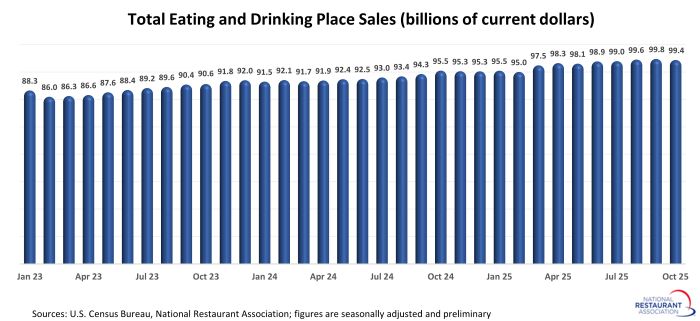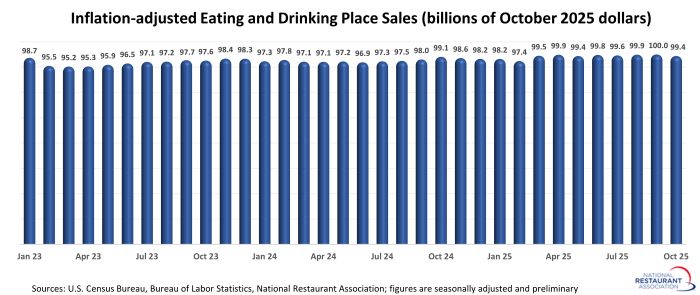Research
December 18, 2025
Total restaurant industry sales
Restaurant sales edged lower in October
Restaurant sales registered a modest decline in October, as consumers became somewhat more cautious in their spending activity.
Eating and drinking places posted total sales of $99.4 billion on a seasonally adjusted basis in October, according to preliminary data from the U.S. Census Bureau. That was down 0.4% from September’s downward-revised sales volume of $99.8 billion.
October’s sales decline came on the heels of 6 gains in the last 7 months – a period during which average monthly spending at restaurants rose by nearly $5 billion.
Despite the decline, eating and drinking place sales stood 4.1% above their year-ago level in October. While still positive, that represented the smallest 12-month increase since February (3.2%).
Consumer spending was a mixed bag in other sectors in October. Sales at non-restaurant retailers rose just 0.1% in October and stood 3.4% above their year-ago levels.

While restaurant sales growth slowed in recent months, menu prices continued to increase at a steady pace. After adjusting for menu price inflation, eating and drinking place sales rose just 0.3% between October 2024 and October 2025.
That represented the smallest real sales gain since February, on a 12-month basis.

Note: Eating and drinking places are the primary component of the U.S. restaurant and foodservice industry and represent approximately 72% of total restaurant and foodservice sales.
Eating and drinking places posted total sales of $99.4 billion on a seasonally adjusted basis in October, according to preliminary data from the U.S. Census Bureau. That was down 0.4% from September’s downward-revised sales volume of $99.8 billion.
October’s sales decline came on the heels of 6 gains in the last 7 months – a period during which average monthly spending at restaurants rose by nearly $5 billion.
Despite the decline, eating and drinking place sales stood 4.1% above their year-ago level in October. While still positive, that represented the smallest 12-month increase since February (3.2%).
Consumer spending was a mixed bag in other sectors in October. Sales at non-restaurant retailers rose just 0.1% in October and stood 3.4% above their year-ago levels.

While restaurant sales growth slowed in recent months, menu prices continued to increase at a steady pace. After adjusting for menu price inflation, eating and drinking place sales rose just 0.3% between October 2024 and October 2025.
That represented the smallest real sales gain since February, on a 12-month basis.

Note: Eating and drinking places are the primary component of the U.S. restaurant and foodservice industry and represent approximately 72% of total restaurant and foodservice sales.